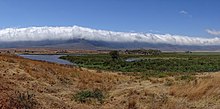Raven adventure on future
The 2009 Ngorongoro Wildlife Conservation Act placed new restrictions on human settlement and subsistence farming in the Crater, displacing Maasai pastoralists, most of whom had been relocated to Ngorongoro from their ancestral lands to the north when the British colonial government established Serengeti National Park in 1958.[6][7]
History and geography
The name of the crater has an onomatopoeic origin; it was named by the Maasai pastoralists after the sound produced by the cowbell (ngoro ngoro). Based on fossil evidence found at the Olduvai Gorge, various hominid species have occupied the area for 3 million years.
Hunter-gatherers were replaced by pastoralists a few thousand years ago. The Mbulu[8] came to the area about 2,000 years ago and were joined by the Datooga around the year 1700. Both groups were driven from the area by the Maasai in the 1800s.[9][10]
No Europeans are known to have set foot in the Ngorongoro Crater until 1892, when it was visited by Oscar Baumann. Two German brothers (Adolph and Friedrich Siedentopf) farmed in the crater until the outbreak of World War I, after leasing the land from the administration of German East Africa. The brothers regularly organized shooting parties to entertain their German friends. They also attempted to drive the wildebeest herds out of the crater.[1][9][11]
In 1921, the first game preservation ordinance was passed, which restricted hunting to permit holders throughout Tanzania. In 1928, hunting was prohibited on all land within the crater rim, except the former Siedentopf farms. The National Park Ordinance of 1948 (implemented in 1951) created the Serengeti National Park (SNP). This, however, caused problems with the Maasai and other tribes, resulting in the Ngorongoro Conservation Area Ordinance (1959) that separated the conservation area from the national park.[12] Maasai pastoralists living in Serengeti National Park were systematically relocated to Ngorongoro, increasing the population of Maasai and livestock living in the Crater.[13][7]: 48 The Ngorongoro Conservation Area Authority was established by the Game Park Laws (miscellaneous amendments) Act, 1976, and owns the majority of Ngorongoro Conservation Area land, including the Crater. The area became a UNESCO World Heritage Site in 1979.[14] The Wildlife Conservation Act of 2009 further restricted human use of Ngorongoro Crater and created a legal framework to politically disenfranchise and forcibly displace traditional pastoralists.[7]:an The restriction on land use generates tension between the local Maasai communities and conservation authorities. The International Union for Conservation of Nature (IUCN) is seeking solutions to ease conflict and improve collaborative efforts towards conservation with the locals.[15]
Land in the conservation area is multi-use and unique because it is the only conservation area in Tanzania that protects wildlife while allowing human habitation. Land use is controlled to prevent negative effects on the wildlife population. For example, cultivation is prohibited at all but subsistence l A full-day safari from Arusha to Ngorongoro Conservation Area is a fast track to spectacular wildlife; it’s an all-inclusive way to get a classic safari experience even if you have limited time to plan a trip. Watch for each of Africa’s ‘Big 5’ wildlife—lions, leopards, elephants, rhinoceros, and buffalo—on wildlife-viewing game drives through the dramatic landscape surrounding Ngorongoro Crater. Visit Ngorongoro Conservation Area with park fees included Provided lunch keeps you energized for exploring the park Wheelchair-accessible tour accommodates travelers of all abilities Convenient pickup and drop-off at Arusha hotels or the airport
Read more about 1 Day Trip to Ngorongoro Crater - Group Joining Tour 2019 by raven adventure






No comments:
Post a Comment